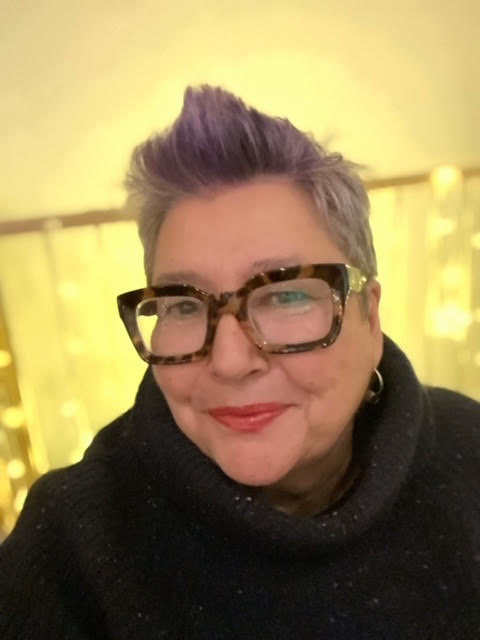Curator Bio: Michelle McGeough, Ph.D
Originally from Amiskwaciwâskahikan, Michelle McGeough is a Métis scholar and artist. Prior to accepting her current position as an Assistant Professor at Concordia University, she taught at the University of British Columbia. Dr. McGeough received her Ph.D. in Indigenous art histories from the University of New Mexico. Since her return to Canada, she has joined the board of Indigenous Curatorial Collective, an indigenous run and led non-for profit. Dr. McGeough serves on the board of the Tegan and Sara Foundation. An international organization that provides financial support through grants to organizations that fight for economic justice, health and representation for self-identified LGBTQ girls and women in both Canada and the USA. She is also a founding member of Shushkitew Collective, an organization of Métis artists and scholars who are working towards Métis equity in the arts.
PodCast
Conversation with Jules Arita Koostachin and Michelle McGeough
Unearthing Secrets, Gathering Truths: Jules Koostachin’s Poetic Response to the Residential School Experience.
Michelle McGeough, Ph.D
Since May 27, 2021, news updates have informed us of the rising count of children found buried in mass unmarked graves on the grounds of residential schools. As Canadians sit down to the evening news and eat their dinner, they are served up the irrefutable evidence of the country’s violent ongoing assault on Indigenous people. Unlike the testimonies of the more-than-6,000 survivors of the residential schools collected by the Truth and Reconciliation Commission, this news can’t be ignored and dismissed by Canada's settler society. [1] The stories the survivors share can no longer be excused as the imaginings of a child’s mind. The unearthing of these mass graves has revealed to the nation tangible proof of the reality of the deplorable conditions and cruelty that occurred within the walls of these sites of genocide.
Whether or not one believes in blood memory or intergenerational trauma, here is the truth of the matter: There isn’t a single Indigenous person who has not been affected by the legacy of the residential school experience. While Canada would like to relegate this travesty to the past and soothe it with a public apology, the reality is that we have only just begun to address the effects of Canada’s genocidal policies, which have torn at the core of our being, undermining our relationships to each other and to the natural world.
The videos commissioned for this exhibition were written and directed by Cree filmmaker Jules Koostachin, based on two poems from her book Unearthing Secrets, Gathering Truth, first published in 2018. The collection contains poems written over twenty years. The creation of these two videos presents a powerful testament, providing the viewer with a deeply personal, intergenerational glimpse into the effects that the settler government’s policies have had on those who survived the genocide.
Koostachin has always wanted to be a storyteller. Arriving in Montreal in 1991, just after the Oka crisis, she saw how the power of documentary film could be used to give voice to Indigenous people’s histories and experiences. She speaks with reverence of Abenaki filmmaker Alanis Obomsawin and the impact that her documentary feature, Kanehsatake: 270 Years of Resistance, had on her own desire to become a filmmaker. Koostachin finished her fine arts degree in theatre, at Concordia University, then went on to Ryerson University to complete an M.A. in documentary media. Most recently, she received her Ph.D., from the University of British Columbia’s Institute of Gender, Race, Sexuality and Social Justice.
The poetry Koostachin has chosen for these videos is indicative of how she mitigates the legacy of being the child of a residential school survivor. On the one hand, she acknowledges the profound effect that settler colonialism has had on her and her family, shaping her most intimate relationships. Yet, there is deep resistance to giving into victimhood. Some may reference this in terms of Gerald Vizenor’s notion of survivance, which he defines as “an active sense of presence, the continuance of native stories, not a mere reaction, or a survivable name.” [2]
However, Koostachin sees her films as more than just pushing back against colonialism. Her passion is fuelled by the desire to honour her ancestors, and specifically, her grandparents. She reflects on how they lived off the land, and that they didn’t have much in terms of material wealth. They became a touchstone for Koostachin. In times of adversity, there was laughter, love, and faith, but no room to lament what might have been. In speaking about the influence of her grandparents on her life, she states, “They are the reason I am alive.” [3]
As Koostachin observes, “There are many ways to come to the truth, but the truth always begins with us. Know your own story first.” [4] Koostachin admits that not everyone is ready for the level of truth she insists upon portraying in her creative endeavours. Such people are not the audience she envisions for her work. Instead, she sees her films as being for the Indigenous community, portraying contemporary life with all its complications.
These poems are an example of Koostachin’s willingness to expose her vulnerabilities and the wounds that come with being an Indigenous woman, the daughter of a residential school warrior, and a mother of four sons. She consistently lays bare all of this in her creative undertakings. In the poems she presents here, each word breaks open a well of collective and individual sorrows that have accumulated as a result of settler colonial rule in Indigenous homelands. The grief we have attempted to contain spills over and we are reminded of how close we came to losing everything that makes us Indigenous: our languages, our ceremonies — all that connects us to our land and each other. Our mourning of what we have lost is balanced by the recognition of what our knowledge-keepers have kept alive. The search and recovery process is as emotional and painful as it is celebratory. This is a hallmark of Koostachin’s work.
The poem “Stolen Cubs”, chosen by Koostachin for this project, is emblematic of this distinctive dual characteristic of her oeuvre. The Bear Mother story is an oral tradition found among many Indigenous people. Throughout time immemorial, Indigenous artists have lovingly carved her likeness into wood and ivory effigies, an act that embodies the cherished reverence this being evokes. Bear Mother’s protective nature towards her offspring taught human beings how to protect their children. In this poem, the words alone evoke a profound sense of grief, but it is layered with meaning by the images of Koostachin wearing a red dress, a visual cue used to evoke the ongoing tragedy of the murdered and missing Indigenous women, children, and Two-spirit people. The visual allegory connects the residential school experience with the continuing violence against the most vulnerable of our Indigenous Nations.
Of the two poems that Koostachin visually illustrates in these videos, “Stolen Cubs” speaks to the trauma of residential schools. We become witnesses to the visceral pain and suffering created by this act of violence. Koostachin's words compel us to feel deeply the despair and loss — the loss felt by Indigenous mothers of their children, the loss of growing up surrounded by one’s ceremonies and languages, and the loss experienced by the Indigenous nations of our leaders, healers, and knowledge-keepers. Koostachin reminds us that mourning is not confined to humans, but is a loss felt by all creation because we have forgotten how to live with those other-than-human beings. “Stolen Cubs” is a sobering portrayal of the violence of settler colonialism and how it continues with the removal of Indigenous children through the settler nation state’s child welfare system.
Conversely, “Shaking Tent”, the second poem chosen by Koostachin, demonstrates a refusal to allow the trauma of the residential school to define her. While the word “resilience” is often deployed to describe Indigenous people’s response to the effects of the residential school experience, Koostachin feels the word is overused. [5] This critique is well founded when you consider that the term infers a return to a previous state. While we might romanticize the past, we know that settler colonialism has forever changed how we relate to each other and the natural world. For Koostachin, the process of healing begins with the recovery of Indigenous languages, traditions, and spiritual practices.
The poem “Shaking Tent” also speaks to the impact of Christianity on Indigenous communities since Christian organizations ran many of the residential schools. Koostachin states that while her grandparents were practising Christians, they understood the Church and its teachings through a Cree lens and embraced aspects of Christian religion that were compatible with their Cree world view. The sustained practice of Indigenous ceremonies, such as the shaking tent, demonstrates the ways Indigenous people continued their spiritual practices despite the looming presence and censor of those who upheld Christian ideals.
In reading this poem, I was reminded of my first understanding of the shaking tent and its use to locate things that had gone missing. Koostachin’s words and imagery in this video provide a much richer explanation of the ceremony. The shaking tent is a portal to other worlds, where our world and the spirit world intersect. She alludes to this with imagery of herself occupying the liminal space of the shoreline. This space separates the land from the water, two seemingly separate worlds. Koostachin’s words tell us of the spirits that occupy this space. They are not like the pious Christian saints, static and frozen in frames that hold their images on the walls of churches. No, these entities are tricksters, but they are as familiar to us as our relatives: they smoke cigarettes and drink tea, they laugh and play bingo while waiting patiently for us to return to our ways, to learn our languages and ceremonies. I see this vision created by Koostachin all around me. The youth are hungering for this knowledge, and we are so fortunate to have the knowledge-keepers, the ones who refused to be shamed into forgetting.
These videos express the contradictions and the complexity of our lives. Koostachin’s words and images underscore both the price we have paid as a result of colonization, and the possibilities offered in lighting a fire for the living to see, [6] something we desperately need as we wait for the accounting of those children who did not return.
1 https://www2.gov.bc.ca/gov/content/governments/indigenous-people/new-relationship/truth-and-reconciliation-commission-calls-to-action
2 Vizenor, Mannifest Manners: Narratives on Postindian Survivance, Lincoln, Neb., University of Nebraska Press, 1999,p.vii.
3 Interview by author with Jules Koostachin, July 8, 2021.
4 Ibid.
5 Op. cit.
6 Koostachin Unearthing Secrets, Gathering Truths, page 30, Kegedonce Press, Owen Sound, Ont., 2018.
Shaking Tent Poetry by Jules Koostachin
Jules Koostachin Poetry Shaking Tent from Liz Barron - Apartment 7 on Vimeo.
Stolen Cubs Poetry by Jules Koostachin
Jules Koostatchin Poetry Stolen Cubs from Liz Barron - Apartment 7 on Vimeo.

